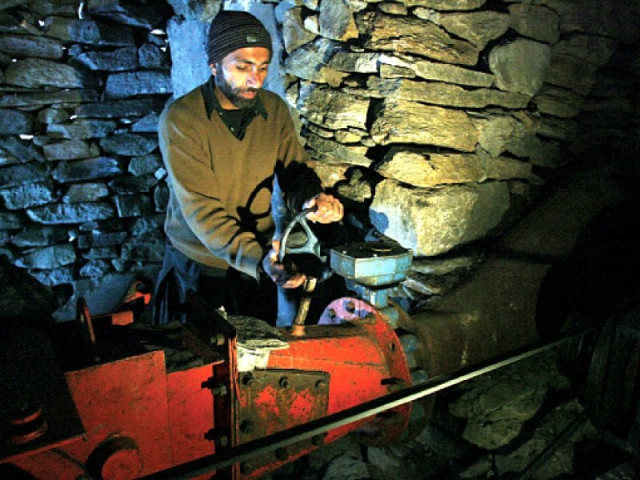PTI govt to fight spectre of power outages
Policymakers say existing power generation plan can’t cater to the rising electricity demand

Technician Rahimullah operates a turbine at a small-scale hydro project in Neelum Valley. PHOTO: AFP
Despite the fact that the former Pakistan Muslim League-Nawaz (PML-N) government added 12,449MW electricity to the national grid under the China Pakistan Economic Corridor (CPEC) energy projects, the PTI government has blamed it for lack of coordination in energy sector and failure to start energy integrated plan to address the threat of load shedding in the coming years.
They claim that the PML-N government also failed to reduce higher losses and improve low recovery of electricity bills leading to circular debt which continues as a big threat in entire energy chain.
The policymakers argued that the PML-N government focused on large thermal projects, notably on imported R-LNG based combined cycle and coal projects and ignored the renewable energy projects.
They argue that 12,449MW were added to the power system. However, the demand-supply gap that had been averaging at over 4,000MW since 2005 could not be overcome due to a constrained transmission and distribution losses as system had not been capable of evacuating a maximum of 19,500MW as opposed to the recorded peak demand of over 25,000MW during the summer season.
In order to make the peak power demand forecast up to 2022-23, the GDP growth projections of international financial institutions as well as relevant national organisations have been consulted. These sources predict an average GDP growth rate of around 5.5% for the next five years.
Accordingly, it has been assumed that electricity demand would grow at the rate of 5.7%, 7.8% and 9.9% under low, normal and high growth scenarios up to the year 2022-23, reveal the policymakers while discussing the energy sector in 12th Five Year Plan (2018-23).
They have projected that current generation plan would be sufficient to meet the low growth scenario which assumes that electricity demand would grow by 5.7%. However, supply would be insufficient to meet the demand under normal and high growth scenarios.
According to the projection, low demand will stand at 38,847MW, normal at 45,607MW and high demand at 52,507MW. However, energy plan is silent about the increase in generation of electricity through new projects in the coming years.
During the 11th plan period, the focus on overcoming power deficit by addition of new generation capacity since 2013 has also resulted in a number of large thermal projects, notably on imported R-LNG based combined cycle and coal projects.
The energy mix, therefore, shows an overall downward trend in the share of hydropower. By 2018-19 the share of hydro in total power generation will fall below 30%, and will decline to 23% by 2020-21.
Thereafter, the share of hydro will rise to about 27% by 2023, and 34% by 2024 if the hydro projects initiated recently – including Tarbela IV and V, Dasu Phase I, and a number of private sector projects – are not delayed.
Share of hydropower would increase further beyond 2023 owing to the completion of mega hydro projects initiated during the tail-end of the 11th plan period, leading to a decreased reliance on thermal based generation in future.
Capacity additions through thermal technologies, ie, coal and nuclear power plants would cater to meet the base load requirements along with the existing thermal power plants during the plan period.
The government wants to increase the share of renewable energy like wind and solar in the final power generation mix to a minimum of 20% by 2030. The country’s power sector started experiencing a shortfall of supply against demand in 2002-03.
The situation continued to worsen over the years with the demand supply deficit averaging over 5,000MW from 2008 onwards. The current peak electricity demand has been computed at 26,741MW during summer and at 20,592MW for the winter season.
During the 11th plan period, the transmission capacity would be increased.


















COMMENTS
Comments are moderated and generally will be posted if they are on-topic and not abusive.
For more information, please see our Comments FAQ